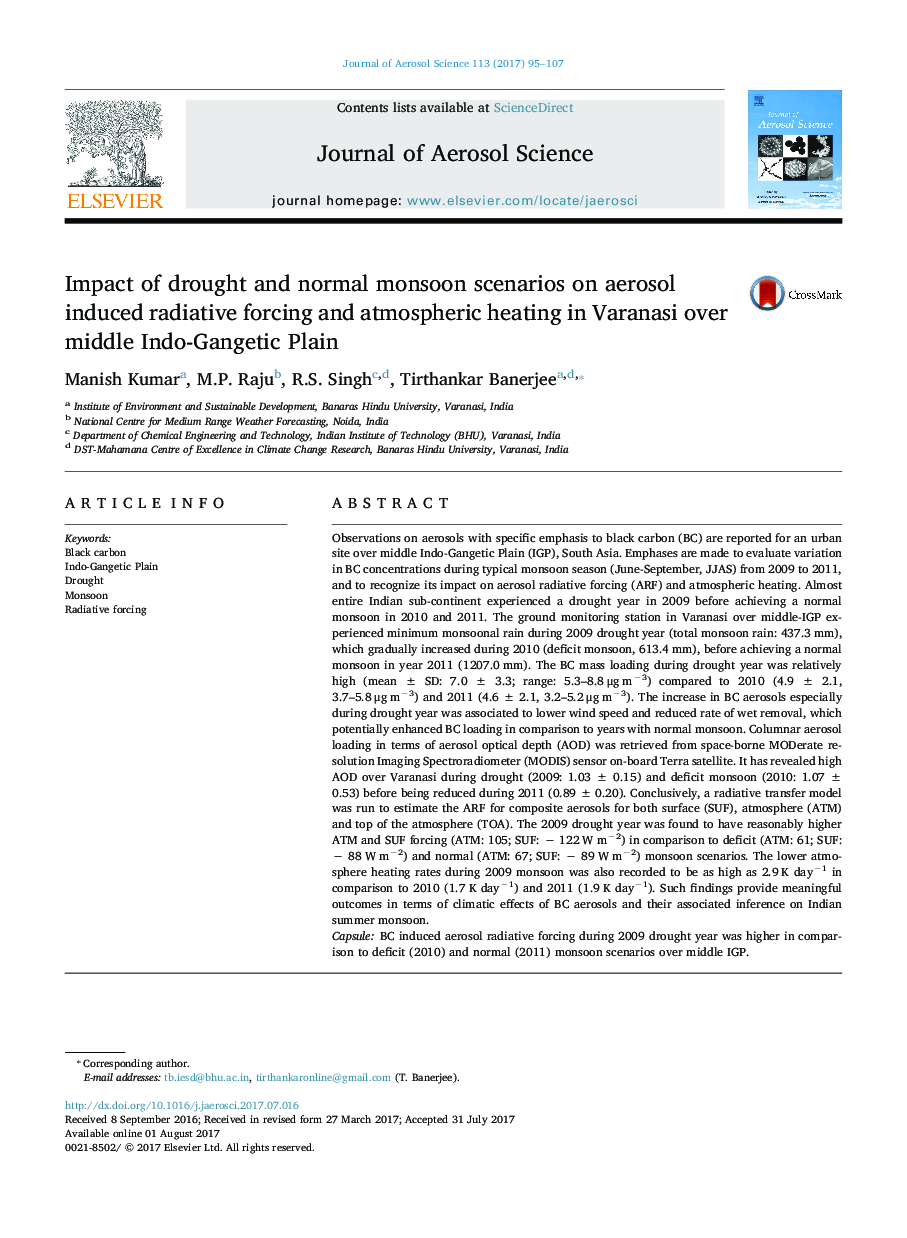| کد مقاله | کد نشریه | سال انتشار | مقاله انگلیسی | نسخه تمام متن |
|---|---|---|---|---|
| 5753912 | 1620710 | 2017 | 13 صفحه PDF | دانلود رایگان |
- Erratic Indian summer monsoon precipitation was recorded during 2009-2011.
- Terra MODIS AOD revealed exceptionally high AOD values over middle-IGP.
- High BC mass loading was evident in 2009 drought year compared to 2010-2011.
- BC induced ATM & SUF forcing was higher in 2009 drought compared to 2010-2011.
- High atmospheric heating rate in 2009 compared to 2010-2011 monsoon scenarios.
Observations on aerosols with specific emphasis to black carbon (BC) are reported for an urban site over middle Indo-Gangetic Plain (IGP), South Asia. Emphases are made to evaluate variation in BC concentrations during typical monsoon season (June-September, JJAS) from 2009 to 2011, and to recognize its impact on aerosol radiative forcing (ARF) and atmospheric heating. Almost entire Indian sub-continent experienced a drought year in 2009 before achieving a normal monsoon in 2010 and 2011. The ground monitoring station in Varanasi over middle-IGP experienced minimum monsoonal rain during 2009 drought year (total monsoon rain: 437.3 mm), which gradually increased during 2010 (deficit monsoon, 613.4 mm), before achieving a normal monsoon in year 2011 (1207.0 mm). The BC mass loading during drought year was relatively high (mean ± SD: 7.0 ± 3.3; range: 5.3-8.8 μg mâ3) compared to 2010 (4.9 ± 2.1, 3.7-5.8 μg mâ3) and 2011 (4.6 ± 2.1, 3.2-5.2 μg mâ3). The increase in BC aerosols especially during drought year was associated to lower wind speed and reduced rate of wet removal, which potentially enhanced BC loading in comparison to years with normal monsoon. Columnar aerosol loading in terms of aerosol optical depth (AOD) was retrieved from space-borne MODerate resolution Imaging Spectroradiometer (MODIS) sensor on-board Terra satellite. It has revealed high AOD over Varanasi during drought (2009: 1.03 ± 0.15) and deficit monsoon (2010: 1.07 ± 0.53) before being reduced during 2011 (0.89 ± 0.20). Conclusively, a radiative transfer model was run to estimate the ARF for composite aerosols for both surface (SUF), atmosphere (ATM) and top of the atmosphere (TOA). The 2009 drought year was found to have reasonably higher ATM and SUF forcing (ATM: 105; SUF: â 122 W mâ2) in comparison to deficit (ATM: 61; SUF: â 88 W mâ2) and normal (ATM: 67; SUF: â 89 W mâ2) monsoon scenarios. The lower atmosphere heating rates during 2009 monsoon was also recorded to be as high as 2.9 K dayâ1 in comparison to 2010 (1.7 K dayâ1) and 2011 (1.9 K dayâ1). Such findings provide meaningful outcomes in terms of climatic effects of BC aerosols and their associated inference on Indian summer monsoon.CapsuleBC induced aerosol radiative forcing during 2009 drought year was higher in comparison to deficit (2010) and normal (2011) monsoon scenarios over middle IGP.
Indian monsoon scenarios during 2009-2011.223
Journal: Journal of Aerosol Science - Volume 113, November 2017, Pages 95-107
